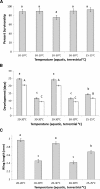Temperature and dengue virus infection in mosquitoes: independent effects on the immature and adult stages
- PMID: 23382163
- PMCID: PMC3592531
- DOI: 10.4269/ajtmh.12-0421
Temperature and dengue virus infection in mosquitoes: independent effects on the immature and adult stages
Abstract
Temperature is one of the most important environmental factors affecting biological processes of mosquitoes, including their interactions with viruses. In these studies, we show independent effects of rearing temperature on the immature aquatic stages and holding temperature on the adult terrestrial stage in terms of alterations in adult survival and progression of dengue-1 virus infection in the Asian tiger mosquito Aedes (Stegomyia) albopictus. Our studies show that adult survival was determined by adult-holding temperature, regardless of rearing conditions of the immature stages. In contrast, spread of virus throughout the body of the mosquito, a pre-requisite for transmission, was reduced when the immature stages were reared in cool conditions. These results show that immature-rearing temperature selectively modified mosquito traits that influence competency for viruses, and they further our understanding of the nature of temperature effects on interactions between mosquitoes and virus pathogens and risk of disease transmission.
Figures




References
-
- Arankalle VA, Shrivastava S, Cherian S, Gunjikar RS, Walimbe AM, Jadhav SM, Sudeep AB, Mishra AC. Genetic divergence of chikungunya viruses in India (1963–2006) with special reference to the 2005–2006 explosive epidemic. J Gen Virol. 2007;88:1967–1976. - PubMed
-
- Paquet C, Quatresovs I, Solet J-L, Sissoko D, Renault P, Pierre V, Cordel H, Lassalle C, Thiria J, Zeller H. Chikungunya outbreak in reunion: epidemiology and surveillance, 2005 to early January 2006. Euro Surveill. 2006;11:E0602023. - PubMed
-
- Rezza G, Nicoletti L, Angelini R, Romi R, Finarelli AC, Panning M, Cordioli P, Fortuna C, Boros S, Magurano F, Silvi G, Angelini P, Dottori M, Ciufolini MG, Majori GC, Cassone A. CHIKV study group Infection with chikungunya virus in Italy: an outbreak in a temperate region. Lancet. 2007;370:1840–1846. - PubMed
Publication types
MeSH terms
LinkOut - more resources
Full Text Sources
Other Literature Sources

